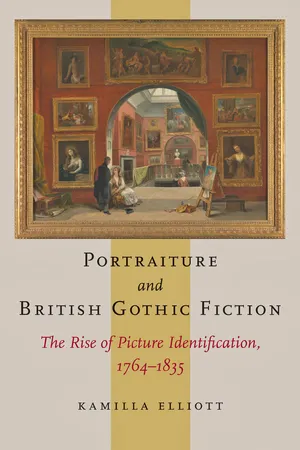
Portraiture and British Gothic Fiction
The Rise of Picture Identification, 1764–1835
- English
- ePUB (mobile friendly)
- Available on iOS & Android
About this book
Examples from British writers of the eighteenth and nineteenth centuries show how portraits became a new mode of identity for the middle class.
Traditionally, kings and rulers were featured on stamps and money, the titled and affluent commissioned busts and portraits, and criminals and missing persons appeared on wanted posters. British writers of the eighteenth and nineteenth centuries, however, reworked ideas about portraiture to promote the value and agendas of the ordinary middle classes.
According to Kamilla Elliott, our current practices of "picture identification" (driver's licenses, passports, and so on) are rooted in these late eighteenth- and early nineteenth-century debates.
Portraiture and British Gothic Fiction examines ways writers such as Horace Walpole, Ann Radcliffe, Mary Shelley, and C. R. Maturin as well as artists, historians, politicians, and periodical authors dealt with changes in how social identities were understood and valued in British culture—specifically, who was represented by portraits and how they were represented as they vied for social power.
Elliott investigates multiple aspects of picture identification: its politics, epistemologies, semiotics, and aesthetics, and the desires and phobias that it produces. Her extensive research not only covers Gothic literature's best-known and most studied texts but also engages with more than 100 Gothic works in total, expanding knowledge of first-wave Gothic fiction as well as opening new windows into familiar work.
Frequently asked questions
- Essential is ideal for learners and professionals who enjoy exploring a wide range of subjects. Access the Essential Library with 800,000+ trusted titles and best-sellers across business, personal growth, and the humanities. Includes unlimited reading time and Standard Read Aloud voice.
- Complete: Perfect for advanced learners and researchers needing full, unrestricted access. Unlock 1.4M+ books across hundreds of subjects, including academic and specialized titles. The Complete Plan also includes advanced features like Premium Read Aloud and Research Assistant.
Please note we cannot support devices running on iOS 13 and Android 7 or earlier. Learn more about using the app.
Information
Table of contents
- Cover Page
- Title Page
- Copyright Page
- Dedication
- Contents
- List of Illustrations
- Acknowledgments
- Note to the Reader
- Introduction
- 1 Theory and/of Picture Identification
- 2 The Politics of Picture Identification
- 3 “The Age of Portraiture” and the Portraiture of Politics
- 4 Matriarchal versus Patriarchal Picture Identification
- 5 Portraits, Progeny, Iconolatry, and Iconoclasm
- 6 Identifying Pictures
- 7 Pictures Identifying
- 8 Iconism and the Aesthetics of Gothic Fiction
- 9 Desiring Picture Identification
- 10 Fearing Picture Identification
- Conclusion
- Notes
- Bibliography
- Index